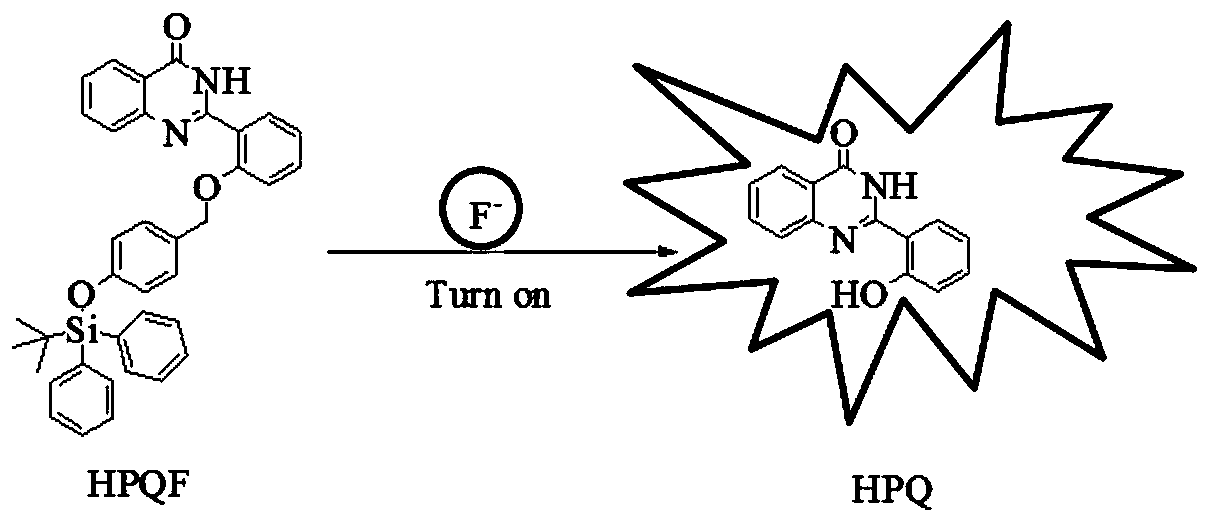A fluorescent probe for detecting fluoride ions in living cells and its preparation method
A technology of fluorescent probes and fluoride ions, which is applied in the field of fluorescent probes, can solve the problems of poor cell membrane penetration and limitation of fluorine ion fluorescence imaging, and achieve the effects of simple post-processing, simple synthesis methods, and high yields
- Summary
- Abstract
- Description
- Claims
- Application Information
AI Technical Summary
Problems solved by technology
Method used
Image
Examples
Embodiment 1
[0025] Embodiment 1: the synthesis of compound HPQF
[0026] Compound a (550.6 mg) and 2-aminobenzamide (177.3 mg) were dissolved in 40 mL of methanol, stirred at 0° C. for 10 minutes, and then refluxed for 30 minutes; then p-toluenesulfonamide (20 mg) was added and continued Reflux for 1 hour; after the reaction solution was cooled to room temperature, dichlorodicyanobenzoquinone (270.8 mg) was added, stirred overnight, and filtered with suction, the resulting filter residue was compound HPQF, with a yield of 70%.
[0027] 1 H NMR (300MHz, CDCl 3 )δ(ppm): 10.96(s, 1H), 8.53(d, J=6.99Hz, 1H), 8.29(d, J=7.86Hz, 1H), 7.77~7.70(m, 6H), 7.48~7.35( m, 8H), 7.20~7.13(m, 3H), 7.07(d, J=8.31Hz, 1H), 6.81(d, J=8.37Hz, 2H), 5.19(s, 2H), 1.11(s, 9H ). 13 C NMR (75MHz, CDCl 3 )δ(ppm):161.69,157.05,156.05,150.88,149.43,135.60,134.45,133.08,132.73,131.58,130.03,128.92,127.90,127.65,126.48,126.47,122.14,121.36,120.54,120.34,113.91,71.55, 26.57. ESI-HRMS C 37 h 34 N 2 o 3 Si[M+Na] ...
Embodiment 2
[0028] Embodiment 2: Compound HPQF detects fluoride ion in vitro
[0029] Dissolve the compound HPQF in DMSO, and prepare 1uL of solutions of different concentrations (20-200uM), then add fluoride ion solutions of different concentrations (0-2000uM) prepared from tetrabutylammonium fluoride (TABF), and wait After 0-10 minutes, set the excitation wavelength to 405nm, and collect the fluorescence signal intensity at the wavelength of 470-530nm. When the concentration of fluoride ion is 20uM, obvious fluorescence "turn-on" effect can be observed.
Embodiment 3
[0030] Example 3: Compound HPQF detects fluoride ions in living cells
[0031] Subculture HepG2 cells for 2-10 hours first, set the experimental group to add fluoride ion solution to co-culture for 1-6 hours, set the blank control group to co-culture with the control solution without fluoride ion for 1-6 hours; then use a large amount of PBS solution repeatedly The HepG2 cells were washed several times to fully remove free extracellular fluoride ions; the compound HPQF (20-200uM) was added to incubate for 0.5-3 hours, and the fluorescence intensity of the two groups of cells was observed by confocal laser microscopy. Experimental results such as image 3 As shown, compared with the blank control group, the fluorescence intensity of the field of view in the experimental group was significantly enhanced, indicating that the compound HPQF has good cell membrane penetration and can be applied to the dynamic monitoring of fluoride ion concentration in living cells.
PUM
 Login to View More
Login to View More Abstract
Description
Claims
Application Information
 Login to View More
Login to View More - R&D
- Intellectual Property
- Life Sciences
- Materials
- Tech Scout
- Unparalleled Data Quality
- Higher Quality Content
- 60% Fewer Hallucinations
Browse by: Latest US Patents, China's latest patents, Technical Efficacy Thesaurus, Application Domain, Technology Topic, Popular Technical Reports.
© 2025 PatSnap. All rights reserved.Legal|Privacy policy|Modern Slavery Act Transparency Statement|Sitemap|About US| Contact US: help@patsnap.com



